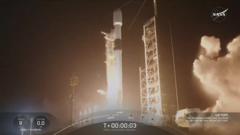SpaceX successfully launched a Falcon 9 rocket carrying two lunar landers from Firefly Aerospace and ispace, marking a significant milestone in the commercial race to the Moon. The landers, which will conduct independent missions upon reaching lunar orbit, are part of a broader initiative supported by NASA to advance lunar exploration and pave the way for future human presence on the Moon.
SpaceX Launches Dual Lunar Missions as Commercial Space Race Expands

SpaceX Launches Dual Lunar Missions as Commercial Space Race Expands
Two lunar landers from private US and Japanese firms embark on a mission to the Moon aboard a SpaceX rocket, ushering in a new era of commercial space exploration.
SpaceX has once again made headlines as its Falcon 9 rocket successfully launched two private lunar landers on Wednesday, further solidifying its position at the forefront of the burgeoning commercial space sector. The mission commenced from the Kennedy Space Center in Florida at 01:09 local time (06:09 GMT), marking a significant step in the quest for lunar exploration.
The two landers—Firefly Aerospace's Blue Ghost and Japan's ispace Resilience—are set to undertake individual missions once they separate in lunar orbit. Firefly's Blue Ghost is expected to take approximately 45 days to reach the Moon, where it will drill for samples and conduct X-ray imaging of the Earth’s magnetic field. The data collected aims to enhance the understanding of potential human missions on the Moon and provide valuable information on how solar activity affects our planet.
On the other hand, ispace’s Resilience lander has a more extended timeline, anticipated to take up to five months before landing on the lunar surface to deploy its rover and gather loose surface material, known as regolith. Both missions are part of a growing trend in commercial lunar endeavors backed by NASA, which stands to benefit from advanced research and sample collection on the Moon.
This launch follows the historic achievement by Intuitive Machines, which successfully completed a commercial lunar landing last year, joining an elite group of nations that have accomplished such a feat. Simultaneously, SpaceX prepares for another major test, with its Starship rocket set for a seventh orbital flight test in Texas. This move is emblematic of the rapidly evolving landscape of space exploration, where private companies are now taking prominent roles in missions once reserved for government agencies.



















